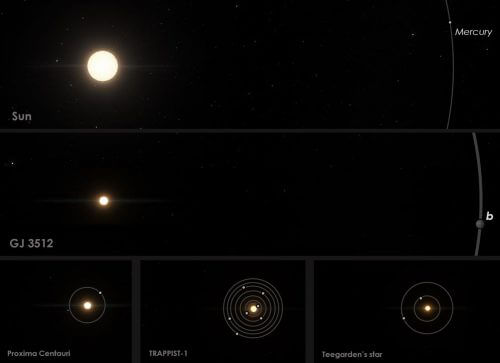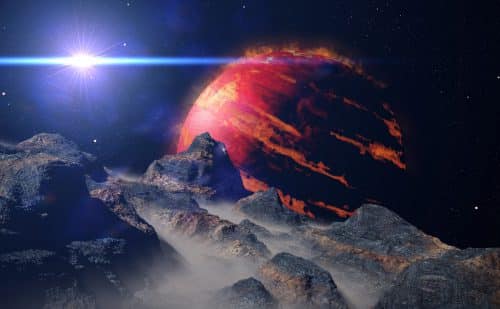The planet, dubbed GJ3512b, is a gas giant moving in a 204-day elliptical orbit. The planet has a mass at least half that of Jupiter and its diameter may be about 70% that of the star it orbits. Therefore it is one of the largest planets known to orbit such a small star in such a wide orbit - and this is a problem for understanding its formation

By: Andrew Norton' Professor of Astrophysics Education, UK Open University. Translation: Avi Blizovsky
The discovery of another planet outside the solar system is no longer news. More than 4,000 planets orbiting other stars have now been found since the discovery of the first extrasolar planet in 1995. As astronomers have long suspected, or at least hoped, planets appear to be found in all star systems and there are probably more planets than stars in our galaxy.
However, it is worth noting a new discovery of a large planet orbiting the small star GJ3512. The paper, published in Science, challenges our understanding of how planets form and further blurs the line between small, cool stars known as dwarfs and large planets.
The star itself is a red dwarf. It lies about 30 light years away from us, its light is faint, only 0.2% of the light emitted by the Sun, its mass is about 12% of the Sun's mass and 14% of its radius. Such dim stars are actually the most common stars in the galaxy, but only one in ten known planets have been found to orbit red dwarfs.
This will likely have an impact on the search method. Red dwarfs are so dark that it is difficult to locate their planets using the "Doppler periodicity" method. This method examines how the wavelength of the star's light changes from time to time (to blue or red) with tiny differences, when the invisible planet rotates around it and pulls the star back and forth. Instead, some of the other planets discovered orbiting red dwarf stars were found using the transit method - looking at how the star's light dims when a planet passes in front of it.
What makes the new discovery stand out is that the planet, dubbed GJ3512b, is a gas giant moving in a 204-day elliptical orbit. The planet has a mass at least half that of Jupiter and its diameter may be about 70% that of the star it orbits. Therefore, it is one of the largest planets known to orbit such a small star in such a wide orbit - and this is a problem for understanding its formation.

The formation of planets
Our solar system was born from a pre-planetary disk - a cloud containing dense gas and dust around our new sun.
The most accepted explanation for how the gas giants formed is that rocky ice cores were formed by the accretion of smaller bodies in the outer regions of the disk. The process continued until these cores reached 10 times the size of the Earth. At this point they were able to collect a shell of hydrogen and helium before the planets migrated to the inner edge of the disk, or the disk dispersed.
This is apparently how giant planets form in most systems, including the so-called "hot Jupiters" discovered in close orbits around their stars. But it is hard to see how planets could form in this way around a low-mass star - the disk would not be massive enough.
An alternative scenario probably happened in the case of GJ3512b - and possibly many other planetary systems of its type. Here the planet appears to have formed by direct fragmentation of the protoplanetary disk. This means that some of the material in the disk has collapsed and condensed (starting from gas to liquid and then solid) into a large body, without having to gradually grow by accreting smaller rocks. This is similar to how the stars themselves are usually formed.
The team behind the new study reports additional evidence for this formation trajectory that suggests the presence of a second giant planet in the system (which, if discovered, will be called GJ3512c) whose orbital period exceeds 1,400 days. This may also explain GJ3512b's unusually elliptical orbit, possibly due to interactions between the two planets shortly after they formed. This process would remove the third star from the system. And if there were once three large planets around such a small star, the only way they could have formed was by the direct splitting of the disk.
A star against a planet
The discovery of this system also has implications for the debate about what is a brown dwarf star and what is a planet. Brown dwarfs are stars that have failed to ignite nuclear fusion in their cores, so they settle for less than 8% the mass of the Sun or about 85 times the mass of Jupiter.
The smallest known brown dwarfs have masses 12 times smaller than that of Jupiter, while the largest known planets have masses 30 times that of Jupiter. So if the most massive planets are heavier than the least massive stars - what differentiates a star from a planet?
One answer is to say that stars form like stars, and planets form like planets, and so mass is somewhat irrelevant. The problem is that we usually can't tell how a planet or brown dwarf formed. In the case of GJ3512b, the probable formation method is more similar to that of a star than that of a planet.
So the picture is even more confused than it was before, and it may only be resolved by future discoveries. Increasing the census of planetary systems will eventually show which creation mechanisms are most common.
For the article in THE CONVERSATION
More of the topic in Hayadan:

6 תגובות
A link to the article for Dr. Alon Rater? Thanks. Amiram
Thanks for the explanation. That is, you claim that the planet was not created in the solar system but came from outside and was trapped in it?
Elliptical of course. Did the speller fix it?
Simple explanation - this is an adopted planet as I predicted in an extraordinary article from 2012. This also explains the great championships.
Many times the terms "gas" and "dust" are used without specifying the chemical composition. Is it known what the composition of the gas and dust is? I would love to know the lineup.
I would appreciate it if you could define the term 'desk' as it is critical to understand the article. Is 'Desca' the mass of the solar system to which the nascent planet belongs?